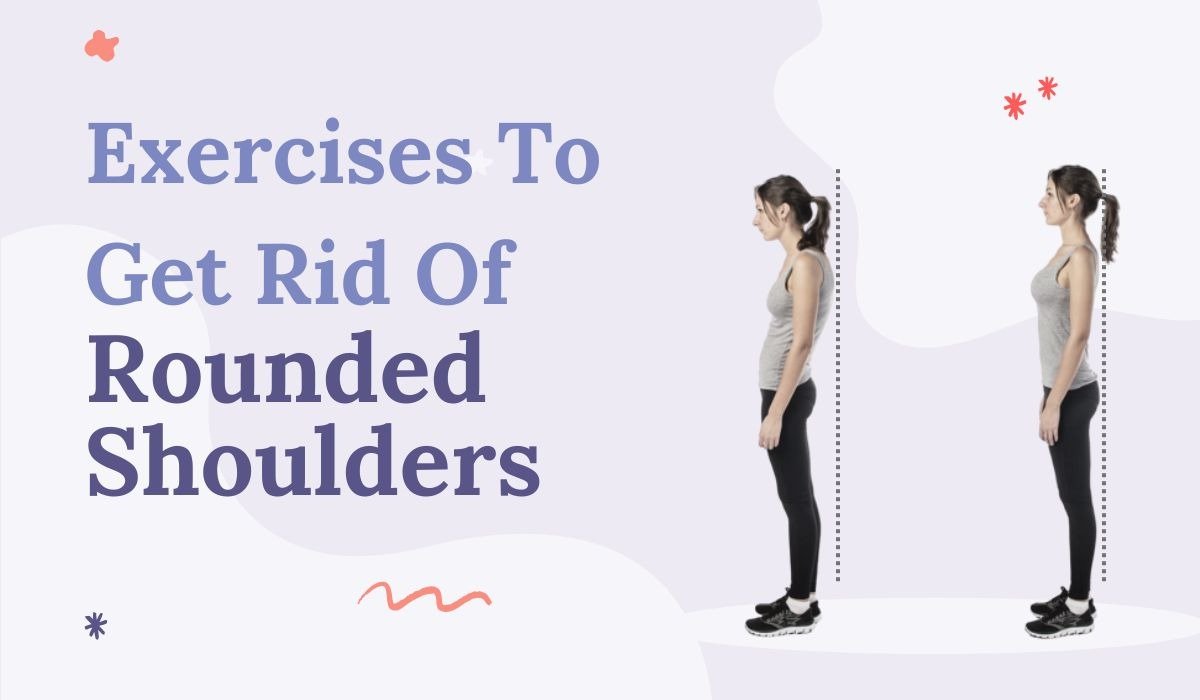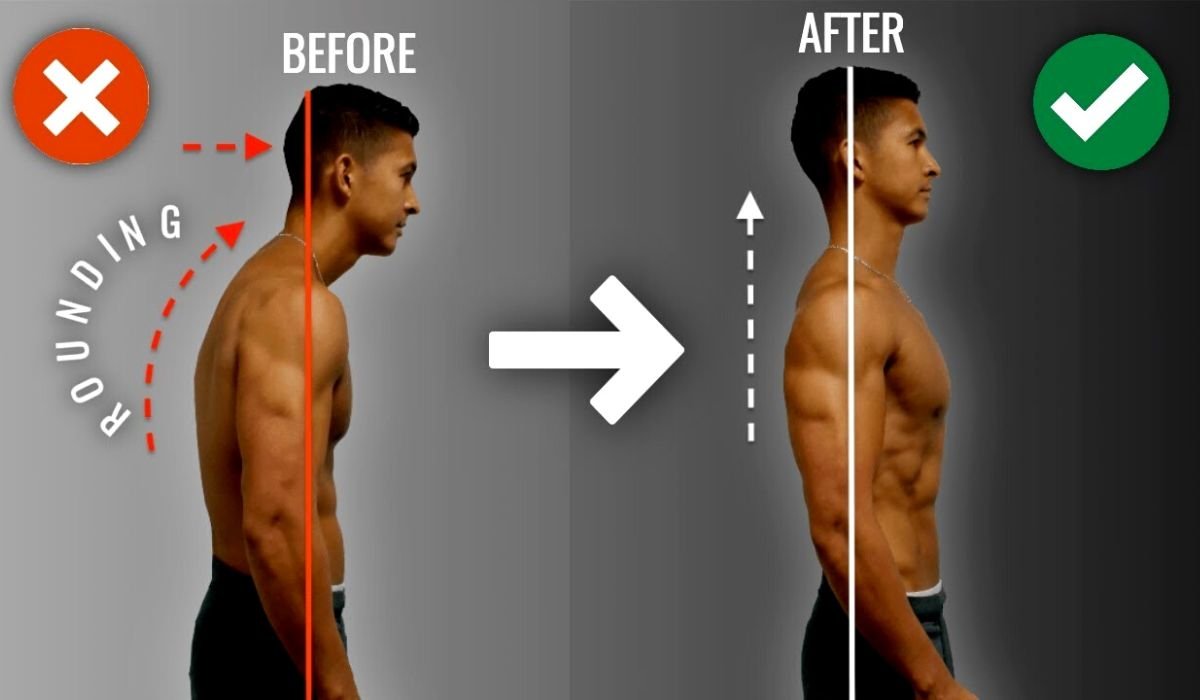Having Trouble With Rounded Shoulders? | Best Exercises For Rounded Shoulders

The shoulders are a complex joint that plays a vital role in human movement and function. They are in fact responsible for many crucial movements such as reaching overhead, lifting and carrying objects, pushing and pulling movements, throwing and catching, etc.
Apart from it, the joint also plays a role in maintaining posture and balance, which is equally important. To put it briefly, the shoulder’s significance in the human body is uncontested.
Exercises To Get Rid Of Rounded Shoulders
Now that we’ve grasped the crucial role that the shoulder plays, we should be wary of the actions that jeopardize its normal functioning. For instance, poor posture habits and overuse of the shoulders can lead to injury and pain in the shoulders, which can last a lifetime if left untreated.
In another way, doctors and medical professionals have stressed this concern so much that they’ve assigned the well-being of the shoulder as an indicator of overall health and well-being.

Now, this is where the issue of rounded shoulders comes in and tells us that “I am a troublemaker, and I am more serious than I look”. Yes, rounded shoulders, a very common phenomenon among the youth now, is not to be ignored and shooed away. Why? Because, unlike your assumptions of it being a posture problem, it can be a sign of muscle imbalances or chronic pain. Yup, not child’s play.
To emphasize the severity even more, bad posture caused by rounded shoulders can result in a number of issues, such as neck pain, headaches, lower back strain, and poor circulation.
But don’t worry; there are tried-and-true ways to fix this and avoid trouble. Through a handful of beneficial exercises and stretches, one can bring back their shoulders to normalcy.
What Are Rounded Shoulders?
So, before heading out to take a walk through the list of exercises, let’s first try to define rounded shoulders.
Also known as forward head posture or hunched shoulders, rounded shoulders are a common postural deviation in which the shoulders roll forward, and the head protrudes forward. This can lead to muscle imbalances and pain in the neck, shoulders, and upper back.
Round shoulders can be a result of bad posture, prolonged sitting, and some repetitive motion-intensive activities like typing or playing musical instruments. So keep in mind to stretch and go for a walk whenever you feel like you are firmly seated in your office chair for a long time.
Because, the stretching and strengthening exercises for the chest, shoulders, and upper back not only improve posture but also reduce pain associated with rounded shoulders.
The List Of Exercises To Fix Rounded Shoulders
Nonetheless, it is important to consult a doctor or a physical therapist for a proper diagnosis and treatment plan if the pain is severe or constant. In short, don’t try to outwit medical science, as it can be too costly to bear afterward.
Exercises & stretches
There are several exercises that can help improve posture and reduce pain associated with rounded shoulders. These exercises focus on stretching and strengthening the muscles that support the shoulders, such as the chest, shoulders, and upper back as we mentioned before.
- Wall slide
The wall slide exercise is a simple and effective exercise that can help improve posture and reduce pain associated with rounded shoulders. The exercise targets the chest, shoulders, and upper back muscles, which can help improve alignment and reduce muscle imbalances.
Here’s how to perform the wall slide exercise:
- Stand with your back against a wall, with your feet about hip-width apart. Your heels, glutes, upper back, and head should be touching the wall.
- Slowly slide your arms up the wall until they are fully extended above your head. Keep your back and head pressed against the wall as you do this.
- Lower your arms back down to the starting position, keeping your back and head pressed against the wall.
- Repeat the movement 10–15 times.
It is important to keep your shoulders down and back as you perform the exercise and to avoid shrugging your shoulders. Also, make sure to keep your core engaged to maintain proper form.
- Scapular wall slides
A variation of the wall slide exercise that specifically targets the muscles of the upper back, also known as the scapular muscles.
Follow these steps:
- Stand shoulder-width apart with your back against a wall.
- Place a rolled-up towel or a foam roller between your shoulder blades, making sure it is pressed firmly against the wall.
- Keep your arms straight and press your hands and wrists against the wall, as if you were pushing the wall away.
- Slowly slide your arms up the wall as you simultaneously squeeze your shoulder blades together.
- Hold the top position for a couple of seconds and then slowly lower your arms back down to the starting position.
- Repeat the exercise for 8–12 reps.
Make sure to keep your core engaged during the exercise, and avoid shrugging your shoulders. The key is to focus on squeezing your shoulder blades together and keeping your arms straight.
- Shoulder blade squeeze
Targets the muscles in the upper back, specifically the rhomboids and the middle trapezius.
- Sit or stand by placing your arms at your sides.
- Without shrugging your shoulders, squeeze your shoulder blades together as if you were trying to bring them together in the middle of your back.
- Hold the contraction for 5 seconds, then release.
- Repeat the exercise for 10–15 reps.
It is important to keep your core engaged and your shoulders down during the exercise to avoid any strain on the neck. Also, make sure to keep your arms relaxed and avoid using them to initiate the movement.
- Lateral neck flexion stretch
Targets the muscles in the side of the neck, specifically the sternocleidomastoid (SCM) muscle, which can become tight and contribute to rounded shoulders and poor posture.
- Stand or sit straight with your shoulders relaxed.
- Tilt your head to one side as if you were trying to touch your ear to your shoulder.
- Use your hand to gently pull your head down further into the stretch, but avoid pushing down on your head.
- Hold the stretch for 15–30 seconds and then release.
- Repeat the stretch on the other side.
It is critical to keep your shoulder relaxed and down during the stretch and avoid shrugging the shoulder of the side you are stretching. Also, try to keep your chin level and avoid tilting it forward or backward.
You can also perform this stretch while seated on a chair. Simply tilt your head to the side and use your hand to gently pull your head down further into the stretch.
- Doorway stretch
Helps to stretch the muscles in the chest, specifically the pectoralis major, which can become tight and contribute to rounded shoulders.
- Stand in a doorway or near a wall corner with your feet shoulder-width apart.
- Place your hand on the door frame or wall corner at about shoulder height.
- Step forward with the opposite foot, keeping your feet shoulder-width apart.
- Keep your arm straight and gently lean forward into the stretch, feeling the stretch in your chest.
- Hold the stretch for 15–30 seconds and then release.
- Repeat the stretch on the other side.
It’s important to keep your shoulder blade down and back while stretching and to avoid rounding your shoulders forward. You can increase the stretch by tilting your head slightly to the opposite side of the stretched arm.
In addition, reverse fly, reverse shoulder stretch, Prone ITY, Band pull, etc are some other popular exercises that help us to treat this condition. But we chose to leave out the same due as it’s quite challenging for many.
Last but not least, remember! These exercises are not in any way substitutes for a proper treatment or a doctoral diagnosis. Hence, if you experience any pain or discomfort during the stretch, stop immediately and consult your doctor or physical therapist.
Dr. Edward Zelman
Dr. Edward Zelman is a distinguished and highly respected medical professional who has dedicated his career to the field of general medicine. With a profound commitment to patient care and a wealth of knowledge acquired over decades of practice, Dr. Zelman has earned a reputation as a trusted healthcare provider in his community. With a career defined by excellence and an unwavering commitment to the betterment of his patients and the broader community, Dr. Edward Zelman stands as a pillar of the medical field, dedicated to the principles of healing and compassionate care. At present, Dr. Edward Zelman is researching safe and effective natural remedies that can restore as well as maintain the youthful functioning of the body.
View All By Dr. Edward






